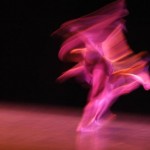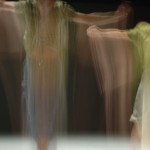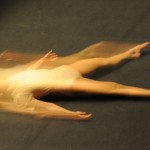Gadi Dagon is dancing. For a photographer, this may
sound somewhat strange. But for Gadi, it's not surprising
in the least. When he was immersed in sports photography,
he showed up one day with a portrait of himself in boxing
gloves, with a crushed nose and blood trickling down his
cheeks to his chin. Just as he once shared the blood of
his sports subjects, as the Batsheva Dance group's
photographer, he shares the dancers' sweat – and
sometimes also their tears
.
In the world of photography, there is one boundary – that
is generally thought to be impassable. That boundary is the
camera itself, which distinguishes between those standing
in front of the lens and those who hide behind it. The ability
to be simultaneously on both sides of the boundary is reminiscent
of the paradoxical locking of a drawer and leaving the key inside.
Gadi Dagon has uncovered the secret of being there on the
stage – or at least – leaving his mark on it – even though his is
an observation point of sorts.
.
The "Boxer" self-portrait is testimony to Dagon’s tendency
to always star on both sides of the fence, to tear down
the invisible wall between the photographer and the photographed.
Nonetheless the boundary continued to divide the two worlds – until,
that is, the advent of digital photography, which led him to the
breakthrough he had been seeking for a long time.
.
Dagon switches the camera to manual mode and sets it to
a relatively slow exposure. This mode enables him to dance
with the camera in the footsteps of the dancers: in the places
where Gadi, and therefore, the lens lingers longer, there is more
light or – that is – the camera’s sensor captures more information.
By contrast, the places he chooses to pass over relatively
quickly acquire a certain transparency. By means of alternately
rapid and slow movements, he creates a gradation that is
reminiscent of the effect achieved in standard photography through
repeated exposures. Thus the photographer, by mastering both the
dancers' body language and the camera's physical attributes – paints
a digital picture of his interpretation of the dance.
.
Gadi Dagon dances behind the scenes or at a window overlooking
the stage – but his dance is documented by the camera he is holding
while he dances. The camera's lens is directed toward Batsheva's
dancers, but on the basis of the resulting photographs the photographer's
dance movements can be traced.
.
Gadi Dagon dances in the dark – but his dance is
etched in millions of light particles playing on the
digital sensor.
.
Gadi Dagon dances with the dancers – mastering the tiniest
movement of their muscles.
.
.
http://www.youtube.com/watch?v=3nOOadP0oeI
.
.
Gadi Dagon dance-paints with his camera. The camera’s
sensor his canvas; time – his paintbrush; the dancers – his
palette
.
Gadi Dagon is the digital dancer.
.
.






















